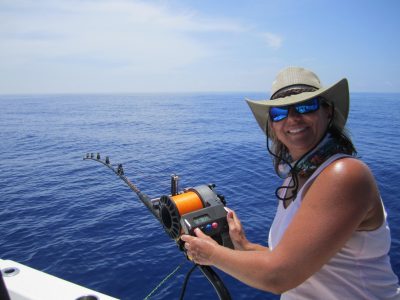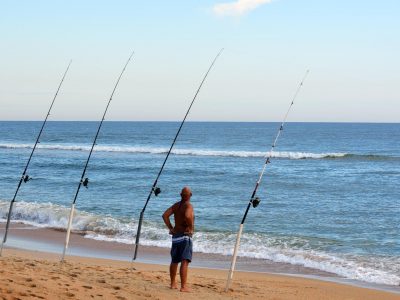Fishing during days with high sea level temperatures requires understanding fish behavior, adapting your fishing techniques, and being mindful of environmental conditions.
Ectothermic Creatures
Fish are ectothermic creatures, meaning their body temperature is influenced by their surrounding environment. On days with high sea level temperatures, fish tend to seek cooler and more comfortable environments to maintain their optimal temperature range.
Understanding this behavior is key to identifying where fish might be located and targeting specific areas accordingly. Shaded areas, deeper waters, or places with strong currents can provide relief from excessive heat for fish.
Tips on Understanding Fish Behavior During Days with High Sea Level Temperatures
Know the species:
Different fish species have varying tolerances to temperature changes. Research and familiarize yourself with the species you’re targeting. Some fish prefer warmer waters, while others seek out cooler areas.
Time Your Fishing Sessions:
During periods of high sea level temperatures, it’s advisable to plan your fishing trips during the cooler parts of the day. Early mornings and late evenings generally offer lower temperatures, which can increase fish activity. As the sun rises higher in the sky, water temperatures tend to rise, leading fish to become less active and seek shelter. By aligning your fishing sessions with these optimal times, you can increase your chances of hooking a catch.
Fish in Shaded Areas:
Shaded areas, such as areas near vegetation, bridges, or structures, can provide cooler spots for fish to gather. These areas offer protection from direct sunlight and can be more attractive to fish during hot days. Targeting shaded areas with suitable covers, such as submerged logs or overhanging branches, can increase your chances of finding fish actively feeding or seeking refuge from the heat.
Focus on Deeper Waters:
Deeper waters tend to be cooler compared to shallow areas during high sea level temperatures. The thermocline, which is the boundary between warm surface waters and cooler depths, can provide a favorable environment for fish seeking relief from the heat. Utilize depth finders or fish finders to locate the thermocline and concentrate your fishing efforts in those areas. Deep drop-offs, channels, or areas near underwater structures can be productive zones.
Adjust Your Fishing Techniques:
During hot days, fish may be less willing to chase after fast-moving lures or baits. Consider adjusting your fishing techniques to match the fish’s behavior. Slow down your retrieve, use smaller and more natural-looking bait presentations, and focus on finesse fishing techniques. By presenting your bait or lure in a subtle and enticing manner, you can entice fish to strike even when they are less active.
There are several warm-water fish species found in the United States. Here are some notable examples:
- Largemouth Bass (Micropterus salmoides): Largemouth bass is one of the most popular sportfish in the United States. They are native to North America and can be found in warm waters throughout the country. Largemouth bass are known for their aggressive feeding behavior and are sought after by recreational anglers.
- Channel Catfish (Ictalurus punctatus): Channel catfish are well-known for their excellent taste and are often targeted by anglers. They are found in rivers, lakes, and reservoirs across the United States, thriving in warm water environments. Channel catfish are opportunistic feeders and can tolerate a wide range of water conditions.
- Bluegill (Lepomis macrochirus): Bluegill, also known as bream or sunfish, are native to North America and are commonly found in warm waters throughout the United States. They are popular among anglers, especially for beginners and recreational fishing. Bluegill inhabits lakes, ponds, and slow-moving rivers.
- Crappie (Pomoxis spp.): Black crappie (Pomoxis nigromaculatus) and white crappie (Pomoxis annularis) are two species of crappie found in the United States. They are popular panfish and are often targeted by anglers. Crappies prefer warm waters and are commonly found in lakes, reservoirs, and slow-moving rivers.
- Flathead Catfish (Pylodictis olivaris): Flathead catfish, also known as yellow catfish, are large predatory fish. They are native to the Mississippi River basin but have been introduced to other parts of the country. Flathead catfish prefer warm, slow-moving waters and are often found in rivers, reservoirs, and lakes.
- Yellowfin Tuna (Thunnus albacares): Yellowfin tuna is a highly migratory fish species found in warm oceanic waters. They are commonly found in the Gulf of Mexico, along the southeastern coast, and in the Atlantic Ocean. Yellowfin tuna can tolerate a wide range of temperatures, from cooler temperate waters to warm tropical waters.
- King Mackerel (Scomberomorus cavalla): King mackerel is a migratory species found in the Gulf of Mexico and along the Atlantic coast of the United States. They prefer water temperatures between 20-30°C (68-86°F) and are known for their fast swimming and powerful strikes.
It is crucial to prioritize the well-being of fish and practice responsible fishing to conserve our marine ecosystems for future generations. Stay informed, be adaptable, and enjoy the challenges and rewards that fishing brings, even during periods of high sea-level temperatures.
By understanding fish behavior during days with high sea level temperatures and implementing these strategies, you can improve your fishing success and make the most out of challenging weather conditions.
Enjoy your time on the water and happy fishing! Download the FishVerify app today and enhance your fishing experience!


